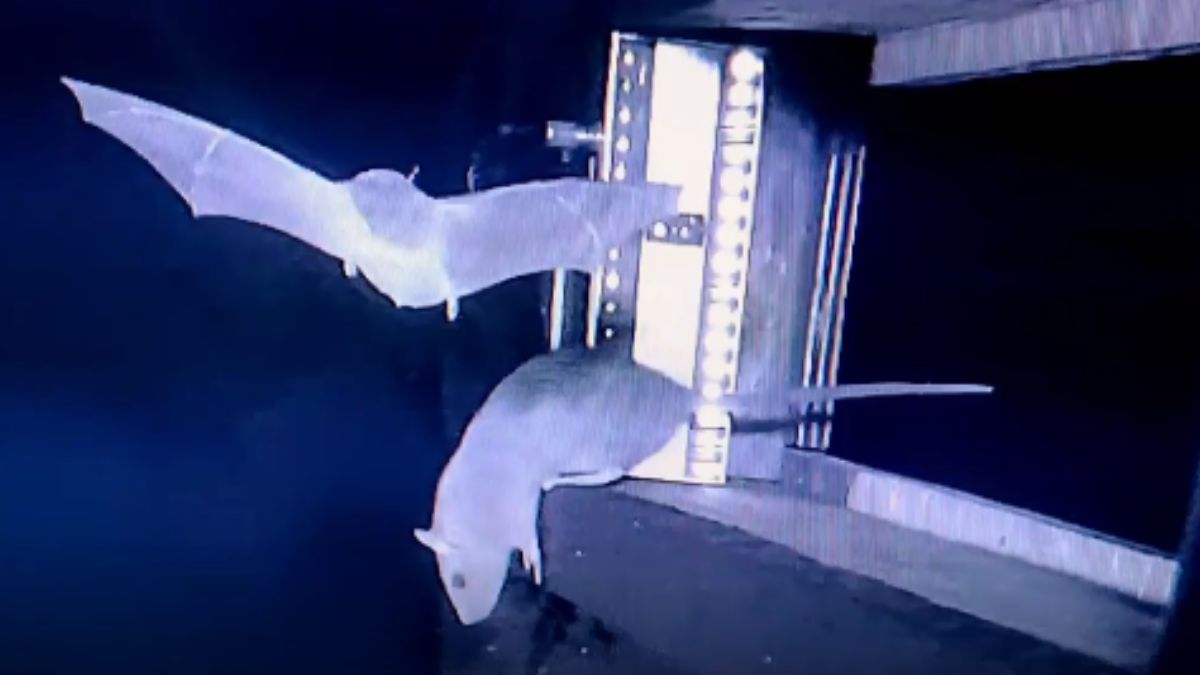Rats hunting bats have raised concerns about a spillover of diseases. In a first, scientists have discovered rodents snatching bats out of the air and eating them.
A study published in the journal Global Ecology and Conservation has warned that this could significantly threaten local bat populations. The rare behaviour is a “remarkable” example of the rodent’s ability to use the best of their environment, researchers say.
Rats caught hunting bats
Scientists captured brown rats snatching bats mid-flight to eat. This behaviour was filmed on infrared and thermal imaging cameras at two major urban bat colonies in northern Germany.
They monitored bats at two hibernation sites in the towns of Segeberg and Lüneburg-Kalkberg over several months between 2020 and 2024.
“Our observations show how adaptable and skillful [brown] rats are in exploiting food resources in urban ecosystems, while highlighting a conservation issue linked to invasive mammals,” lead author Florian Gloza-Rausch, a biologist at the Museum of Natural History in Berlin, said in a statement. “To our knowledge, this type of rat behaviour has not previously been documented scientifically.”
Findings of the study
The videos revealed two distinct hunting styles. Some rats stood straight, using their tails for balance as they clutched the bats out of the air. Others attacked the bats when they were on the ground.
At Bad Segeberg, a cave located near a busy open-air theatre, researchers captured the footage of brown rats hunting bats as they entered and exited the cave on 30 occasions. This site is used for winter roost by more than 30,000 bats.
The team found 13 confirmed kills over five weeks. As many as 52 bat remains were also located, some of which had not yet been fully eaten.
“Rats were frequently observed patrolling the landing platform at the cave entrance,” the researchers wrote. “They were standing upright on their hind legs, using their tails for balance and raising their forelegs to intercept flying bats. Individuals were documented capturing bats mid-air, killing them immediately with a bite and dragging them away.”
Impact Shorts
More ShortsAll the kills were recorded in the darkness of night. Scientists suspect the rats detected the bats by feeling them with their whiskers or by sensing the air currents from the bats’ wings, owing to their poor eyesight.
At the Lüneburg site, situated in a public park, researchers did not find any successful hunts. However, they found many carcasses that indicated the rats were also hunting bats there.
ALSO READ: Plant Pandemic is Real: How a disease is threatening wheat, the world’s most important food crop
Impact on bats’ population
Gloza-Rausch, lead author of the study, said the hunting method used by the rats underscores a conservation issue.
To study how it will affect local bat populations, researchers carried out some calculations.
They found that even a small rat colony could kill up to seven per cent of the nearly 30,000 bats at the Segeberg site in a single winter.
Invasive rats can destroy native animal populations on islands. But the study shows rodents may have a similar effect in urban environments. The bats in Bad Segeberg and Lüneburg are already facing other threats, including light pollution and development. Now, they also have hungry rats to watch out for.
“Management of invasive rodents at important bat hibernation sites supports biodiversity conservation,” the team wrote in the study. Managing these rats also “reduces potential public health impacts as part of a One Health strategy (an approach that considers the health of humans, animals and the environment together).”
Is this a pandemic scare?
Scientists have warned that bat-murdering rats pose a potential risk for humans
The study did not investigate the transmission of diseases. But the researchers pointed out that both species carry a wide variety of pathogens.
“Such interactions may facilitate the spillover of bat-associated pathogens to rodents, potentially altering disease dynamics and expanding transmission opportunities to humans and domestic animals,” they wrote.
Co-author Mirjam Knörnschild recommended controlling invasive rat populations at key bat hibernation sites, saying such efforts would “protect vulnerable bat populations and reduce potential public health risks” at the same time.
With inputs from agencies


)

)
)
)
)
)
)
)
)



